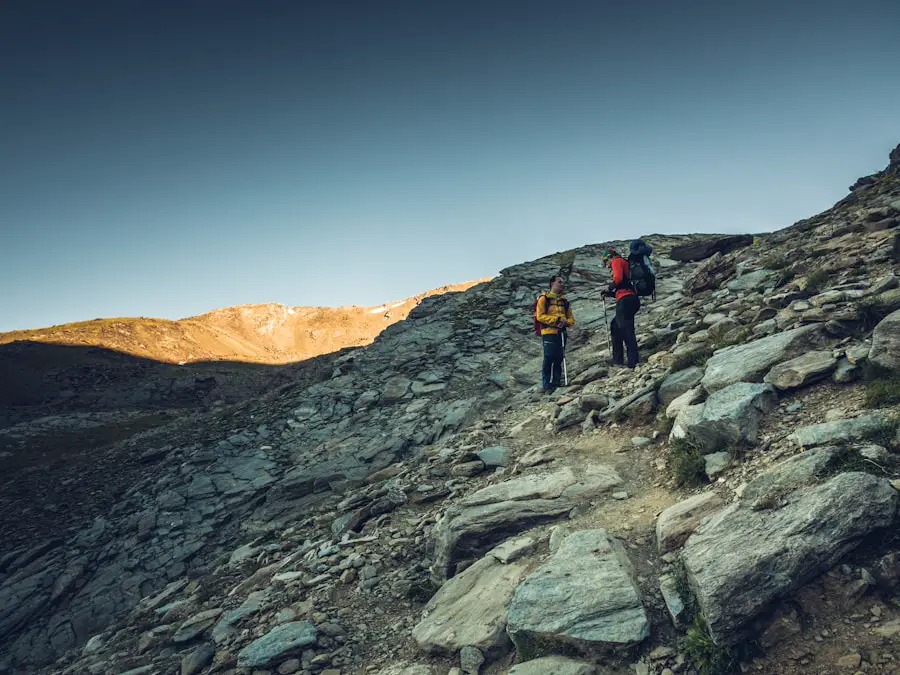High altitude, generally defined as elevations above 8,000 feet (2,400 meters), presents a unique set of challenges for hikers and mountaineers. At these elevations, the atmospheric pressure decreases, leading to a reduction in the amount of oxygen available in the air. This phenomenon can result in a range of physiological responses in the human body, including acute mountain sickness (AMS), which can manifest as headaches, nausea, dizziness, and fatigue.
The risk of AMS increases significantly as one ascends beyond 10,000 feet (3,048 meters), where the body struggles to adapt to the lower oxygen levels. Understanding these effects is crucial for anyone planning to hike at high altitudes. The body employs several mechanisms to cope with reduced oxygen availability.
Initially, an increase in breathing rate occurs, allowing for greater oxygen intake. Over time, the body may produce more red blood cells to enhance oxygen transport. However, these adaptations take time, which is why gradual ascent is often recommended.
Additionally, individuals may experience changes in their sleep patterns and increased susceptibility to cold temperatures due to the thinner atmosphere. Recognizing these physiological changes can help hikers prepare adequately for their high-altitude adventures.
Key Takeaways
- High altitude can have various effects on the body, including decreased oxygen levels, increased heart rate, and potential altitude sickness.
- Physical preparation for high altitude hiking should include cardiovascular and strength training, as well as gradually increasing elevation gain in hikes.
- Mental preparation for high altitude hiking involves being aware of the potential challenges and being mentally resilient to overcome them.
- Packing essentials for high altitude hiking should include proper clothing, footwear, navigation tools, first aid kit, and emergency supplies.
- Hydration and nutrition at high altitudes are crucial, requiring increased water intake and a diet rich in carbohydrates and electrolytes.
Physical Preparation for High Altitude Hiking
Physical preparation is paramount for anyone intending to tackle high-altitude hikes. Engaging in a well-rounded fitness regimen that includes cardiovascular training, strength building, and flexibility exercises can significantly enhance one’s ability to cope with the rigors of high-altitude environments. Aerobic exercises such as running, cycling, or swimming improve cardiovascular endurance, which is essential for maintaining stamina during prolonged exertion at high elevations.
Incorporating interval training can also be beneficial, as it mimics the bursts of energy required during steep ascents. Strength training should not be overlooked; building muscle strength in the legs and core can provide the necessary support for navigating rugged terrain. Exercises like squats, lunges, and deadlifts can enhance leg strength, while planks and other core workouts improve stability and balance.
Flexibility exercises such as yoga or dynamic stretching can help prevent injuries and improve overall mobility. A well-rounded physical preparation program not only enhances performance but also boosts confidence when facing the challenges of high-altitude hiking.
Mental Preparation for High Altitude Hiking

Mental preparation is equally important as physical readiness when it comes to high-altitude hiking. The psychological challenges posed by altitude can be just as daunting as the physical ones. Hikers may encounter fear of heights, anxiety about altitude sickness, or simply the mental fatigue that comes with long days on the trail.
Developing mental resilience through visualization techniques can be an effective strategy. By picturing oneself successfully navigating challenging sections of the hike or reaching the summit, hikers can bolster their confidence and reduce anxiety. Mindfulness practices can also play a significant role in mental preparation.
Techniques such as meditation or focused breathing exercises can help hikers maintain a calm demeanor in stressful situations. Additionally, setting realistic goals and breaking down the hike into manageable segments can alleviate feelings of overwhelm. By focusing on small achievements along the way rather than fixating on the final destination, hikers can cultivate a positive mindset that enhances their overall experience.
Packing Essentials for High Altitude Hiking
| Item | Quantity | Weight (oz) |
|---|---|---|
| Backpack | 1 | 40 |
| Tent | 1 | 60 |
| Sleeping Bag | 1 | 32 |
| Sleeping Pad | 1 | 20 |
| Water Bottle | 2 | 16 |
| Water Purification | 1 | 3 |
| Stove | 1 | 20 |
| Cookware | 1 | 12 |
| Food (per day) | 1.5 lbs | N/A |
| Clothing Layers | Varies | N/A |
When preparing for a high-altitude hike, careful consideration must be given to packing essentials. The right gear can make a significant difference in comfort and safety during the journey. A sturdy pair of hiking boots designed for rugged terrain is crucial; they should provide adequate ankle support and traction to navigate rocky paths.
Additionally, moisture-wicking clothing layers are essential for regulating body temperature and managing sweat. Base layers should be breathable, while insulating layers and waterproof outer shells protect against cold and wet conditions. Other packing essentials include a reliable backpack that distributes weight evenly and has enough capacity for all necessary gear.
Navigation tools such as maps, compasses, or GPS devices are vital for staying on course in remote areas. A first-aid kit tailored for high-altitude conditions should also be included, containing items like altitude sickness medication, pain relievers, and blister treatment supplies. Furthermore, packing sufficient food and snacks that are high in carbohydrates and protein will help maintain energy levels throughout the hike.
Hydration and Nutrition at High Altitudes
Hydration and nutrition are critical components of high-altitude hiking that often require special attention due to the unique challenges posed by elevation. At higher altitudes, the body tends to lose moisture more rapidly through respiration and perspiration, making it essential to drink water regularly even if one does not feel thirsty. Dehydration can exacerbate symptoms of altitude sickness and lead to decreased physical performance.
Hikers should aim to consume at least three to four liters of water per day while on the trail, adjusting this amount based on individual needs and environmental conditions. Nutrition plays an equally vital role in sustaining energy levels during high-altitude hikes. Foods rich in carbohydrates provide quick energy sources that are easily digestible at altitude.
Complex carbohydrates such as whole grains, fruits, and vegetables should be staples in a hiker’s diet leading up to and during the hike. Protein-rich snacks like nuts or jerky can help with muscle recovery after strenuous sections of the trail. It is also advisable to avoid excessive alcohol or caffeine consumption before and during hikes, as these substances can contribute to dehydration and hinder acclimatization efforts.
Acclimatization Techniques for High Altitude Hiking

Acclimatization is a critical process that allows the body to adjust to lower oxygen levels at high altitudes. To minimize the risk of altitude sickness, hikers should incorporate acclimatization techniques into their plans. One effective method is to ascend gradually; this means spending extra days at intermediate elevations before reaching higher altitudes.
For instance, if planning to summit a peak at 14,000 feet (4,267 meters), it may be beneficial to spend a few nights at 10,000 feet (3,048 meters) to allow the body time to adapt. Another technique involves incorporating rest days into the hiking itinerary. These days allow hikers to remain at a certain elevation while engaging in light activities such as short hikes or exploration of the surrounding area.
This approach not only aids acclimatization but also helps maintain morale during longer treks. Monitoring one’s own body for signs of altitude sickness is essential; if symptoms arise, it may be necessary to descend to a lower elevation until they subside.
Safety Tips for High Altitude Hiking
Safety should always be a top priority when embarking on high-altitude hikes. One of the most important safety tips is to be aware of weather conditions and potential changes that can occur rapidly at higher elevations. Sudden storms or temperature drops can pose serious risks; therefore, checking weather forecasts before heading out and being prepared for unexpected changes is crucial.
Carrying appropriate gear such as extra layers, rain gear, and emergency supplies can make a significant difference in ensuring safety during adverse conditions. Additionally, hiking with a partner or group is highly recommended for safety reasons. In case of an emergency or if someone experiences altitude sickness, having companions can provide immediate assistance and support.
It is also wise to establish clear communication protocols among group members regarding pace and rest breaks to ensure everyone remains together and accounted for throughout the hike. Lastly, understanding one’s own limits is vital; if fatigue sets in or symptoms of altitude sickness appear, it is essential to listen to one’s body and make decisions accordingly.
Environmental Considerations for High Altitude Hiking
High-altitude hiking often takes place in fragile ecosystems that require careful consideration from hikers. The impact of human activity on these environments can be significant; therefore, practicing Leave No Trace principles is essential for preserving natural habitats. This includes packing out all trash, minimizing campfire use, and staying on designated trails to prevent soil erosion and damage to vegetation.
Moreover, hikers should be mindful of wildlife encounters at high altitudes. Many animals inhabit these regions and may be sensitive to human presence; maintaining a respectful distance is crucial for both safety and conservation efforts. Additionally, understanding local regulations regarding camping and hiking practices helps protect these delicate ecosystems from overuse or degradation.
By being conscientious about their impact on the environment, hikers can contribute positively to the preservation of high-altitude landscapes for future generations to enjoy.
When preparing for hiking in high altitude, it is important to consider the type of gear you will need to stay comfortable and safe. One essential item to pack is a high-quality pair of merino wool travel socks, which are odor-resistant and moisture-wicking to keep your feet dry and blister-free during long hikes. For international travel adventures, having a universal travel adapter is a must to ensure you can charge your devices no matter where you are. Additionally, investing in the best sleeping bag for backpacking travel will ensure you stay warm and cozy during chilly nights in the mountains. For more tips on preparing for high altitude hiking, check out this related article.
Love travel? Join Our Facebook Community For More Tips.
FAQs
What is considered high altitude for hiking?
High altitude for hiking is typically considered to be any elevation above 8,000 feet (2,400 meters) above sea level.
What are the potential risks of hiking in high altitude?
Hiking in high altitude can pose risks such as altitude sickness, dehydration, sunburn, and hypothermia due to thinner air, lower temperatures, and increased UV exposure.
How can I prepare for hiking in high altitude?
To prepare for hiking in high altitude, it is recommended to acclimatize slowly, stay hydrated, protect yourself from the sun, dress in layers, and be aware of the signs of altitude sickness.
What should I pack for hiking in high altitude?
When hiking in high altitude, it is important to pack essentials such as plenty of water, high-energy snacks, sunscreen, sunglasses, a hat, layers of clothing, a first aid kit, and a map and compass or GPS.
What are some tips for hiking in high altitude?
Some tips for hiking in high altitude include taking it slow, staying hydrated, eating high-energy snacks, protecting yourself from the sun, dressing in layers, and being aware of the signs of altitude sickness.
